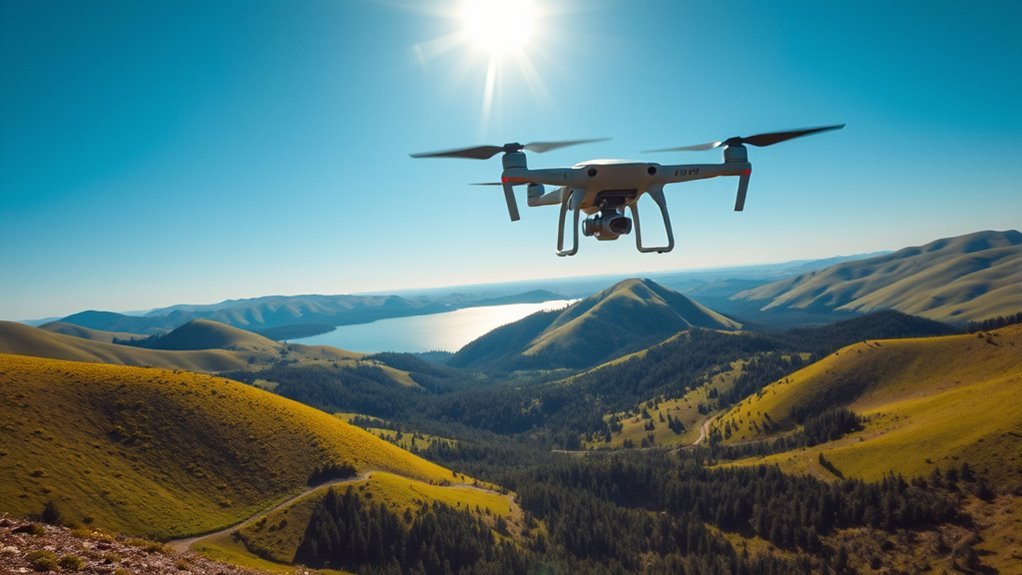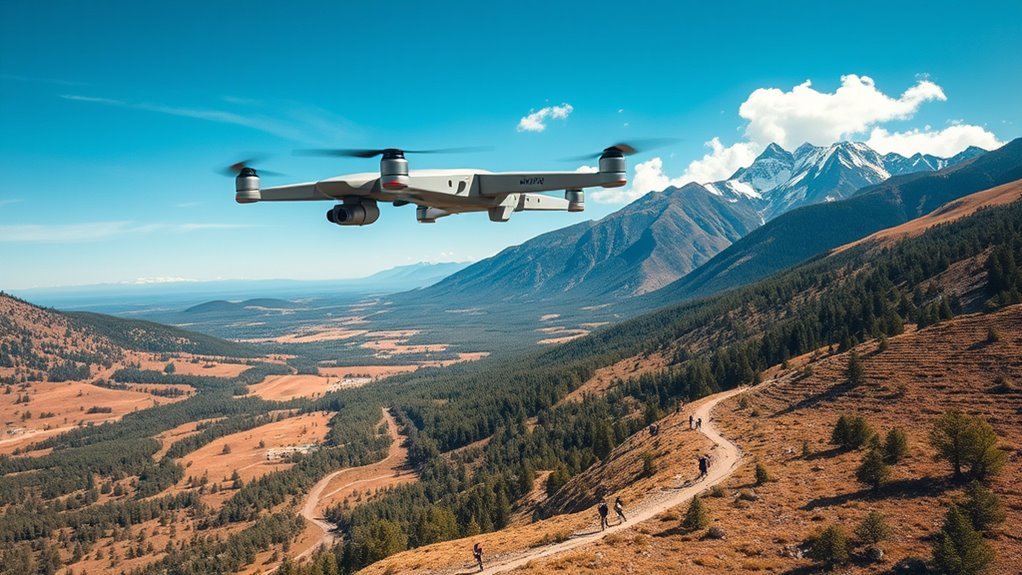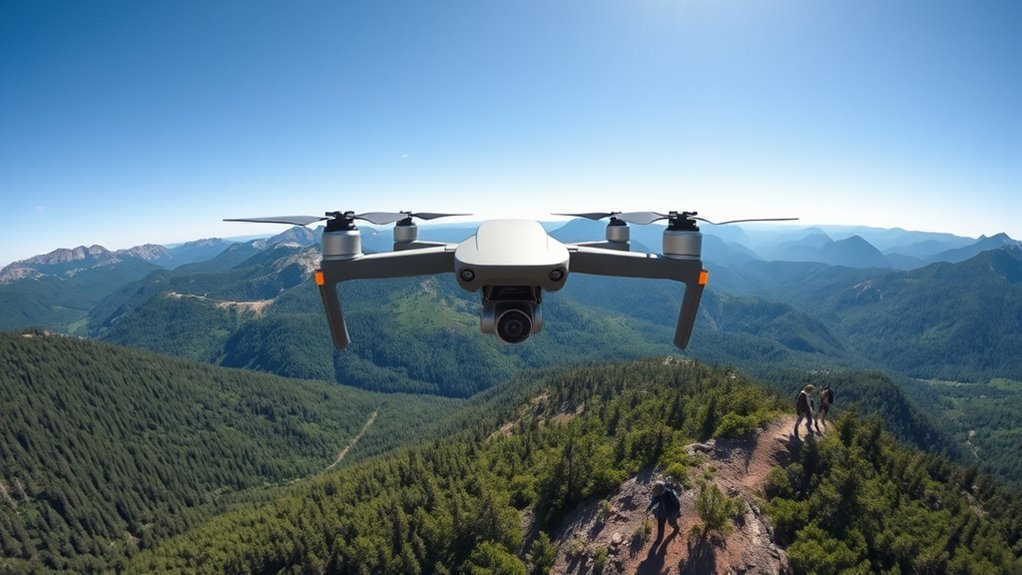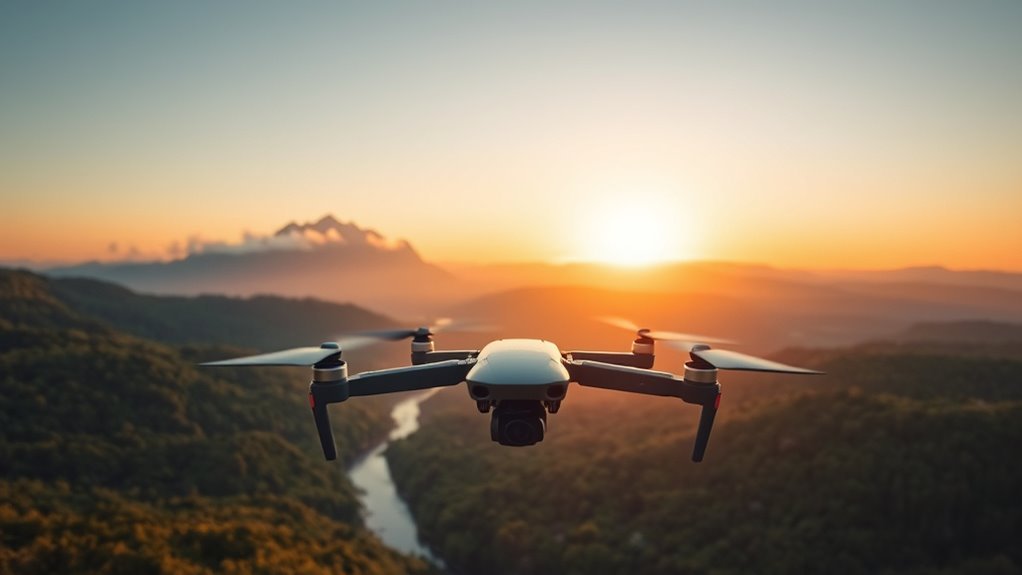Before flying your drone in national parks, make certain you understand the regulations and check for required permits. Identify no-fly zones to protect wildlife and historical sites. Plan your flight path, considering weather and safety. Maintain a visual line of sight and respect nature by keeping a distance from wildlife. Stay informed about changing regulations to guarantee you’re compliant. By following these steps, you can enjoy a great aerial experience while respecting the park’s environment and resources.
Understanding National Park Regulations

When you’re planning to fly your drone in a national park, it’s important to understand the specific regulations that govern drone use. Most national parks prohibit drone flying to protect wildlife and preserve the natural environment. Before you take off, verify your drone is registered according to federal guidelines; this is vital for compliance. Familiarize yourself with any additional local regulations that may apply in the park you’re visiting. Understanding these rules not only keeps you within legal bounds but also enhances your flying experience. By respecting the regulations, you contribute to the preservation of these beautiful landscapes, guaranteeing that future generations can enjoy them too. Your passion for flying can coexist with responsible usage—embrace the freedom, but fly smart!
Checking for Required Permits

Before taking your drone into a national park, it’s essential to check if you need any specific permits. Different permit types exist depending on the park’s regulations and the nature of your flight. Some parks require a special use permit for commercial or educational purposes, while recreational flyers might not need one at all. To find out what’s necessary, visit the National Park Service website or contact the park directly. Familiarize yourself with the application processes, as they can vary greatly. Some permits might take weeks to process, so plan ahead to avoid disappointment. By securing the right permits, you’ll guarantee a smooth, enjoyable flying experience while respecting the park’s rules and preserving its beauty.
Identifying No-Fly Zones

Before you take to the skies, it’s essential to identify no-fly zones within national parks. Regulations and restrictions can vary widely, so it’s important to check local park policies and use available map resources for accurate information. Staying informed not only keeps your drone safe but also protects the delicate ecosystems these parks endeavor to preserve.
Regulations and Restrictions
Although flying a drone can offer breathtaking views and unique photography opportunities, understanding the regulations and restrictions governing national parks is imperative to confirm compliance and protect the natural environment. Many parks have designated no-fly zones, often near wildlife habitats or historical sites, where drone usage is prohibited. It’s essential to check these restrictions before your flight. Additionally, having drone insurance can provide peace of mind in case of accidents. Safety training is also critical; it helps guarantee you’re well-prepared to operate your drone responsibly. By respecting these regulations, you not only enhance your flying experience but also contribute to the preservation of the stunning landscapes and ecosystems that national parks have to offer.
Map Resources Available
Maneuvering the complex landscape of drone regulations in national parks requires access to accurate map resources that clearly identify no-fly zones. Utilizing the right mapping tools can enhance your flying experience while ensuring compliance. Here are some key resources to evaluate:
- FAA’s UAS Data: Offers up-to-date information on airspace restrictions.
- National Park Service Maps: Provides specific no-fly zone information for each park.
- Drone Safety Apps: Many apps feature live map accessibility, showing real-time drone regulations.
Local Park Policies
Understanding local park policies is essential for any drone pilot looking to fly in national parks. Before you launch, familiarize yourself with local park regulations specific to drone usage. Many parks have designated no-fly zones to protect wildlife, preserve natural beauty, and guarantee visitor safety. Ignoring these policies can not only ruin your flying experience but also lead to fines or legal action.
Check with the National Park Service or the park’s official website for up-to-date drone usage policies. They often provide maps outlining restricted areas. By respecting these regulations, you can enjoy the freedom of flying your drone while also protecting the environment and wildlife. So, always plan ahead to keep your adventure smooth and compliant.
Planning Your Flight Path
When planning your flight path in a national park, you need to start by researching park regulations to guarantee compliance. Next, identify scenic locations that not only enhance your footage but also align with any restrictions. Finally, don’t forget to factor in weather conditions, as they can greatly impact your drone’s performance and safety.
Research Park Regulations
Before you take to the skies with your drone in a national park, it’s essential to thoroughly research the park’s regulations, as each park has its own specific rules regarding drone usage. Understanding these rules not only guarantees your drone safety but also minimizes your environmental impact. Here’s what you should focus on:
- Flight Restrictions: Check for any designated no-fly zones or specific altitudes.
- Permits Required: Some parks may require permits for drone operation, so be sure to apply in advance.
- Wildlife Protection: Be aware of areas where drone use might disturb local wildlife or habitats.
Identify Scenic Locations
After familiarizing yourself with the park’s regulations, the next step is to identify scenic locations that will enhance your aerial photography and videography experience. Look for picturesque scenic viewpoints and photography hotspots that showcase the park’s natural beauty.
Here’s a table to help you pinpoint some of the best locations:
| Scenic Viewpoints | Photography Hotspots |
|---|---|
| Sunrise Point | Emerald Lake |
| Grand Canyon Overlook | Hidden Falls |
| Glacier Point | Wildflower Meadows |
| Desert View Tower | Lake Reflection Areas |
| Old Faithful Geyser | Rocky Mountain Peaks |
These locations will not only provide stunning visuals but also allow you to capture the essence of the park from unique angles. Happy flying!
Plan for Weather Conditions
Although it might be tempting to launch your drone at the first sign of clear skies, planning for weather conditions is essential to guarantee a safe and successful flight. Understanding local weather patterns and seasonal changes can help you avoid unexpected turbulence or sudden storms.
Consider these factors before you fly:
- Wind Speed: High winds can affect your drone’s stability. Check forecasts for gusts.
- Visibility: Fog or rain can impair your drone’s camera and navigation systems, so aim for clear visibility.
- Temperature: Extreme cold or heat can impact battery life, so monitor temperature changes throughout your flight.
Best Practices for Safe Flying
When you decide to fly your drone in a national park, keeping safety at the forefront is essential to guarantee a smooth experience for both you and the natural environment. Practicing good drone etiquette and managing your battery life effectively can make all the difference. Here’s a quick overview of best practices:
| Best Practices | Description |
|---|---|
| Check Regulations | Review local park rules before flying. |
| Fly Responsibly | Avoid crowded areas and wildlife. |
| Maintain Line of Sight | Keep your drone within visual range. |
| Monitor Battery Levels | Always keep track of power remaining. |
| Respect Nature | Avoid disturbing wildlife and habitats. Always remember to understand local regulations that govern drone flights in specific areas to ensure compliance and safety, including designated areas where drone use is permitted. |
Capturing Stunning Aerial Shots
As you commence on the adventure of capturing stunning aerial shots in national parks, understanding the unique perspectives these locations offer is essential. Here are some aerial photography tips and drone composition techniques to elevate your skills:
- Use Leading Lines: Incorporate natural lines like rivers or trails to guide the viewer’s eye and create depth.
- Golden Hour Magic: Shoot during sunrise or sunset for softer light and vibrant colors that enhance your landscapes.
- Experiment with Angles: Don’t just shoot straight down; try different heights and angles for a dynamic composition.
Respecting Wildlife and Natural Resources
Capturing breathtaking aerial shots in national parks is just part of the experience; equally important is the responsibility that comes with it. When flying your drone, always prioritize minimizing wildlife disturbance. Animals can be sensitive to noise and movement, which might lead to stress or abandonment of their habitats. This not only affects individual species but can also have a broader ecological impact on the park’s ecosystem.
Keep your distance from nesting sites and feeding areas, and avoid flying during sensitive times, like breeding seasons. By respecting wildlife and natural resources, you help preserve the park’s beauty for future generations while enjoying the freedom of flight. Remember, your actions can greatly influence the delicate balance of nature.
Understanding the Risks of Drone Flying
While the thrill of flying your drone in national parks can be exhilarating, it’s essential to understand the inherent risks involved. A thorough risk assessment is vital for ensuring drone safety and protecting the stunning environments you’re exploring. Here are some key risks to evaluate:
- Wildlife Disturbance: Drones can disrupt animals, leading to stress or abandonment of nests.
- Environmental Impact: The noise and presence of drones can alter the natural atmosphere, affecting both flora and fauna.
- Technical Failures: Mechanical issues or loss of signal can result in crashes, potentially harming visitors or damaging resources.
Staying Informed About Changes in Regulations
Understanding the risks of flying your drone in national parks underscores the importance of staying updated on evolving regulations. Laws can change rapidly, and it’s your responsibility to be aware of these shifts. Regularly checking official park websites and following news related to drone regulations is essential. Additionally, be mindful that federal laws may impose restrictions on drone usage in certain areas, including national parks. It is also crucial to understand drone classification to ensure compliance with both federal and local regulations.
Here’s a quick reference table to help you:
| Source | Purpose |
|---|---|
| National Park Service | Official regulations and updates |
| FAA Website | Federal drone laws |
| Local Park Offices | Specific park rules |
| Drone Community Forums | User experiences and news |
| Social Media Groups | Real-time updates and discussions |
Frequently Asked Questions
Can I Fly a Drone at Night in National Parks?
You can’t fly a drone at night in national parks due to strict park regulations. Always check for specific rules before your flight; understanding these limitations guarantees you enjoy your freedom safely and responsibly.
What Should I Do if My Drone Malfunctions During Flight?
If your drone malfunctions mid-flight, don’t panic. Start drone troubleshooting immediately, following emergency procedures. Assess the situation, attempt to regain control, and safely land it. Always be prepared for unexpected challenges, ensuring your flying freedom.
Are There Specific Drone Models Recommended for National Park Use?
When considering drone models for national parks, focus on specifications like battery life and camera quality. Research model comparisons to find the best fit for your needs while ensuring compliance with park regulations for an enjoyable experience.
How Do I Report an Incident Involving My Drone in a National Park?
Imagine you accidentally crash your drone into a park ranger’s vehicle. To report the incident, contact park authorities immediately, providing details about the accident and adhering to park regulations for incident reporting.
Can I Use My Drone for Commercial Purposes in National Parks?
You can’t use your drone for commercial purposes in national parks without obtaining the necessary commercial permits. Familiarize yourself with drone regulations to guarantee compliance and protect the natural beauty of these treasured lands.

